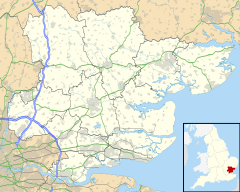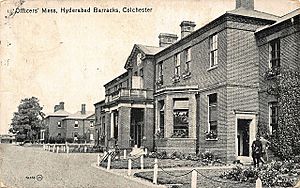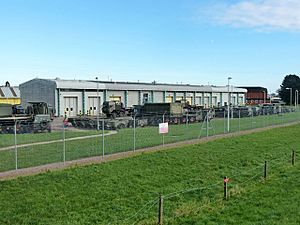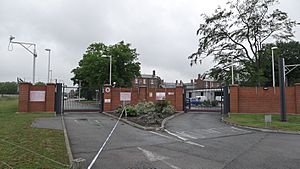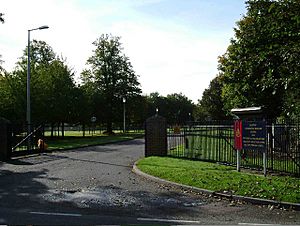Colchester Garrison facts for kids
Quick facts for kids Colchester Garrison |
|
|---|---|
 Colchester Garrison from above |
|
| OS grid reference | TL997254 |
| District |
|
| Shire county | |
| Region | |
| Country | England |
| Sovereign state | United Kingdom |
| Post town | COLCHESTER |
| Postcode district | CO1 – CO16 |
| Dialling code | 01206 |
| Police | Essex |
| Fire | Essex |
| Ambulance | East of England |
| EU Parliament | East of England |
| UK Parliament |
|
Colchester Garrison is a very important military base in Colchester, Essex, England. It has been a key army spot for a very long time. The first permanent army base was set up by the Roman army in AD 43. This happened after the Romans took over Britain.
Colchester was a busy army town during the Napoleonic Wars and the Victorian era. Many soldiers for Kitchener's Army trained here during the First World War. Today, the Parachute Regiment has two battalions, the 2nd and 3rd, based here. New buildings have replaced the older ones. This has also freed up land closer to the town centre.
Contents
History of Colchester Garrison
Napoleonic Wars (1792–1815)
Colchester Garrison played a big part in the Napoleonic Wars. At first, soldiers stayed in local inns and houses. But in 1794, new barracks (army living quarters) were built for infantry soldiers. By 1800, more barracks for infantry, artillery, and cavalry were added. These were in the area near Barrack Street, Wimpole Road, and Port Lane.
In 1805, about 7,000 officers and soldiers lived at the barracks. After the Napoleonic Wars, the base became smaller. The old barracks land was sold off between 1817 and 1840. The Army kept 14 acres (5.7 hectares) and barracks for 851 soldiers. Much of the old barracks land became the "New Town" area of Colchester.
Crimean War (1854–1856)
Colchester Garrison grew quickly during the Crimean War. Between 1855 and 1856, wooden barracks were built for 5,000 soldiers. These were on Ordnance Field. In 1857, the government bought 167 acres (67.6 hectares) of Middlewick Farm. This land was used for training and as a rifle range. The Middlewick Ranges are still used by the army today.
British German Legion
In 1856, about 10,000 soldiers from the British German Legion stayed in Colchester. They lived in the barracks and in tents on Barrack Field. The British German Legion was formed in 1854. It was a group of foreign soldiers serving the British. They were meant to fight in the Crimean War.
Many of these soldiers went to Crimea but did not fight. Most sadly died from fever. The Legion was disbanded in Colchester in 1857. Many soldiers then moved to South Africa. Many German soldiers married local Colchester girls before they left. These marriages happened in Colchester churches, especially St Botolph's.
First World War (1914–1918)
Territorial Force
The Territorial Force was made up of part-time soldiers. They were ready to serve if needed.
Essex Regiment
The 8th (Cyclist) Battalion, Essex Regiment, was based in Colchester in August 1914. It became the 1/8th Battalion as more volunteer battalions were formed. The 2/8th and 3/8th Battalions were created in 1914 and 1915. All three battalions stayed in the UK for home defence during the war.
Essex Yeomanry
The Essex Yeomanry (EY) was a cavalry (horse-riding) regiment. It was called into action at the start of the war. In November 1914, the regiment joined other cavalry units in France. During the war, more regiments were formed in Colchester to support the main one.
In March 1918, the Essex Yeomanry changed. They became a cyclist unit, then a machine gun battalion. But a German attack changed these plans. The regiment went back to horses and joined the 1st Cavalry Division.
Essex Royal Horse Artillery
The Essex Battery, RHA was called up in Colchester and Chelmsford in 1914. This was a Territorial Force unit. A second unit, the 2/1st Essex Battery, RHA, was formed later.
Kitchener's Army
The 12th (Eastern) Division was put together in Colchester from 1914 to 1915. This was one of the first "New Army" divisions formed by Lord Kitchener. It included battalions from many different regiments. These soldiers came from Essex, Suffolk, Norfolk, and other areas. The division moved to France in 1915. They fought in major battles like the Battle of Loos and the Battle of the Somme.
Second World War (1939–1945)
4th Infantry Division
Colchester was the home base for the 4th Infantry Division in September 1939. Units stationed there included the 2nd Battalion Lancashire Fusiliers and the 1st Battalion East Surrey Regiment. Artillery and anti-tank regiments were also present. The division went to France in 1940 as part of the British Expeditionary Force.
Home Guard
During the war, the town was defended by local volunteers. These were part of the 8th Essex Battalion of the Home Guard. At its peak, the battalion had over 2,000 men. They had many types of weapons, including machine guns and flame throwers. Another battalion helped protect important communication systems.
The Home Guard was told to "stand down" on 1 November 1944. They had a final parade on 19 November. Colonel Sir Francis Whitmore thanked them for their duty and patriotism. He said they played a big part in defending the country during a very difficult time.
Colchester Stop Line
During the war, Colchester was surrounded by over 120 pillboxes. These were small defensive structures. A few of these pillboxes can still be found around the area today. You can see them at Mount Bures and near the Hythe railway station.
Colchester Blitz
Air raid sirens sounded over 1,000 times in Colchester during the war. The German air force, the Luftwaffe, attacked Colchester several times.
- Severalls Raid: On 11 August 1942, 38 people died when a German plane dropped bombs on Severalls Hospital.
- Chapel Street Raid: On 28 September 1942, eight people died. A German plane dropped four bombs on South Street and Essex Street. The air raid siren only sounded after the bombs had already fallen.
- St Botolphs Raid: In February 1944, a large firebombing raid happened. About 1,400 firebombs were dropped on the St Botolphs area. This destroyed 14 buildings and badly damaged 99 others. Two-thirds of the Paxman Britannia Works factory was destroyed.
Home Guard anti-aircraft guns were set up on Abbey Field. They fired at enemy planes 14 times over 21 months.
Americans in Colchester
The first American soldiers arrived in Britain in January 1942. Many US air bases were set up near Colchester. These included bases at Earls Colne, Langham, and Wormingford. The American Red Cross set up social clubs for soldiers in the area.
Post-war
The headquarters for the Eastern District of the British Army was in Colchester in 1967. Later, it moved to York in 1992. The garrison was rebuilt between 2004 and 2008. This big project cost £540 million.
Colchester Garrison Today
Regular Army
Colchester Garrison is now home to the British Army's 16th Air Assault Brigade. This brigade has three air assault infantry battalions. It also has two aviation regiments and one artillery regiment. Other units like engineers, signals, logistics, and medical teams support them.
Army Reserve
Colchester has a long history of local volunteers serving in the Territorial Army. This is now known as the Army Reserve. During the Second World War, Colchester's "Terriers" included the 2nd/5th Battalion Essex Regiment. Today, the Army Reserve in Colchester includes 161 Squadron 254 Medical Regiment and 36 (Eastern) Signal Squadron.
Garrison Church
The old Garrison Church on Military Road was once a hospital. It was built in 1856 and is the oldest surviving building on the base. This old church is now used by the Russian Orthodox Church Outside Russia (ROCOR).
In 2007, services moved to a new church. This new church was built as part of the ongoing updates to Colchester Garrison.
Barracks
Here are some of the barracks (living areas for soldiers) at Colchester Garrison:
- Merville Barracks (Gryphon Road) - This is the main headquarters for 16 Air Assault Brigade. It also houses the 2nd and 3rd Battalions of The Parachute Regiment. Other units like the Royal Corps of Signals and Royal Army Medical Corps are here too.
- Goojerat Barracks (Goojerat Road) - Home to the Royal Military Police.
- Berechurch Hall Camp (Berechurch Hall Road) - This is where the Military Corrective Training Centre is located.
- Territorial Army Centre (Circular Road East Lower) - Used by Army Reserve units.
Some former barracks are now part of Merville Barracks. They are no longer separate from the main base.
- Kirkee and McMunn Barracks (Reed Hall Avenue)
- Roman Barracks (Roman Way)
Former Barracks (Not in Use)
- Cavalry Barracks (Circular Road North) - Built in 1862–1863 for cavalry. It was sometimes used as a temporary camp. The large parade ground here was used in the TV show Blackadder Goes Forth. It also appeared in Monty Python's The Meaning of Life.
- Le Cateau Barracks (Le Cateau Road) - This was the Royal Artillery Barracks. It was named after the Battle of Le Cateau from 1914.
- Gymnasium (Circular Road South) - Built in 1862.
- Meeanee Barracks (Mersea Road) - Now developed into housing.
- Hyderabad Barracks (Mersea Road) - Also developed into housing.
- Garrison Church (Military Road) - Now used by the Russian Orthodox church.
Former Barracks (Demolished)
- Sobraon Barracks (Circular Road South) - An infantry barracks built in 1900, torn down in the 1960s.
- Military Hospital - A Victorian building, torn down in the 1990s.
- Cherrytree Camp (Cherrytree Lane) - Used until the 1960s. It was built before World War I for temporary housing. Now it is a housing estate.
Military Corrective Training Centre (MCTC)
Berechurch Hall Camp is home to the Armed Forces Military Corrective Training Centre (MCTC). This is the only military facility of its kind in the UK. It is not a prison for most people. Instead, it helps military personnel improve their discipline.
People at MCTC fall into three groups:
- Those who will stay in the military after their time there.
- Those who will leave the military after their time there.
- Those held in military custody while waiting for investigations or transfer to a civilian prison.
BFBS Radio
BFBS Radio now provides the radio broadcasting service for the Colchester area. They took over from Garrison Radio.
|


